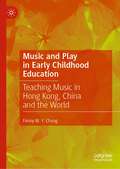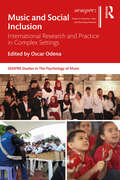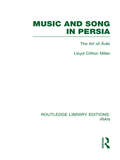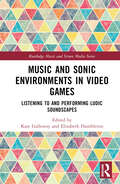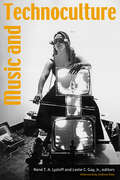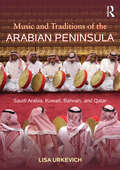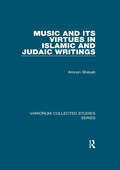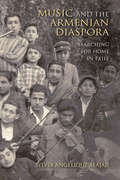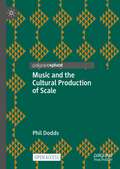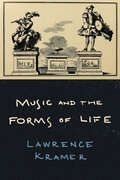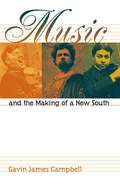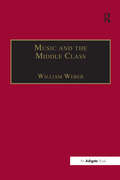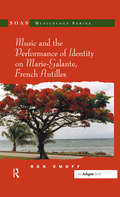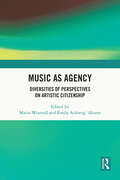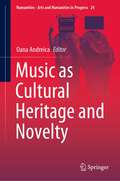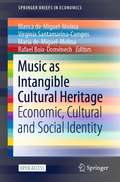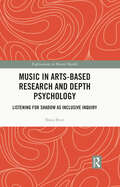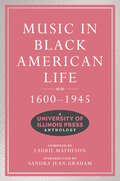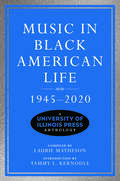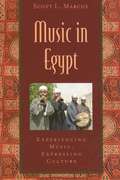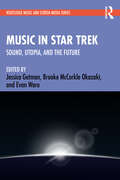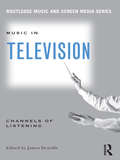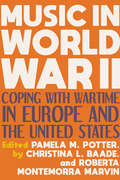- Table View
- List View
Music and Play in Early Childhood Education: Teaching Music in Hong Kong, China and the World
by Fanny M. ChungThis book provides critical insights into the interplay of sociocultural change and educational practices by elucidating the trajectory of Hong Kong’s early childhood music education system. It presents an extensive analysis of postcolonial music education in relation to globalization, westernization, cosmopolitanism, and nationalization. It makes contributions to the theoretical arguments that can be used to interpret the impact of China on the previously Western orientation of education in Hong Kong. This book also explicitly problematizes the theoretical foundations of mandated policies such as play-based learning and moral education in early childhood through music in Hong Kong and across the globe. The analysis of historical context, political influences, and education ideologies in Hong Kong’s early childhood education subsystem provides fertile ground for a thorough understanding of the meaning and implications of globalization in education at multiple levels. Many empirical-based discussions in this book reflect the ideologies, trends, and practices of music education globally. Framed by Bandura’s social cognitive theory, the empirical studies discussed in the book explore the self-efficacy and practices of education leaders and teachers, reflecting the contemporary challenges of music education. Ultimately, it makes a vital contribution by offering a new conceptual model of music teacher education within a globally resonant framework.
Music and Social Inclusion: International Research and Practice in Complex Settings (SEMPRE Studies in The Psychology of Music)
by Oscar OdenaHow do we develop social inclusion through musical activities? What is the power of music in enhancing individual inclusion, group cohesion, and cross-community work in post-conflict environments? How can we investigate social music programmes and interventions? This comprehensive volume offers new research on these questions by an international team of experts from the fields of music education, music psychology, ethnomusicology, and community music. The book celebrates the rich diversity of ways in which learners of all ages participate in social music projects in complex settings. Contributions focus broadly on musical and social processes, considering its conceptualisation and practices in a number of contexts. The authors examine how social music projects can be fostered in complex settings, drawing examples from schools and community settings. These critical chapters will inspire readers to think deeply about social music interventions and their development. The book will be of crucial interest to educators, policymakers, researchers, and students, as it draws on applied research from across 14 countries, of which ten are in the Global South.
Music and Song in Persia: The Art of Avaz (Routledge Library Editions: Iran)
by Lloyd MillerThis book is the first full-length analysis of the theory and practice of Persian singing, demonstrating the centrality of Persian elements in the music of the Islamic Middle Ages, their relevance to both contemporary and traditional Iranian music and their interaction with classical Persian poetry and metrics.
Music and Sonic Environments in Video Games: Listening to and Performing Ludic Soundscapes (Routledge Music and Screen Media Series)
by Kate Galloway and Elizabeth HambletonMusic and Sonic Environments in Video Games brings together a range of perspectives that explore how music and sound in video games interact with virtual and real environments, often in innovative and unexpected ways. Drawing on a range of game case studies and disciplinary perspectives, the contributors consider the sonic environment in games as its own storytelling medium. Highlighting how dynamic video game soundscapes respond to players’ movements, engage them in collaborative composition, and actively contribute to worldbuilding, the chapters discuss topics including genre conventions around soundscape design, how sonic environments shape players’ perceptions, how game sound and music model ecological processes and nonhuman relationships, and issues of cultural and geographic representation.Together, the essays in this volume bring game music and sound into the environmental humanities and transform our understanding of sonic environments as an essential part of storytelling in interactive media. Engaging a wide variety of game genres and communities of play, this book will be of interest to students and scholars of music, media studies, critical game studies, popular culture, and sound studies.
Music and Technoculture
by Andrew Ross Leslie C. Gay Jr. René T. LysloffMoving from web to field, from Victorian parlor to 21st-century mall, the 15 essays gathered here yield new insights regarding the intersection of local culture, musical creativity and technological possibilities. Inspired by the concept of "technoculture," the authors locate technology squarely in the middle of expressive culture: they are concerned with how technology culturally informs and infuses aspects of everyday life and musical experience, and they argue that this merger does not necessarily result in a "cultural grayout," but instead often produces exciting new possibilities. In this collection, we find evidence of musical practices and ways of knowing music that are informed or even significantly transformed by new technologies, yet remain profoundly local in style and meaning. CONTRIBUTORS: Leslie C. Gay, Jr., Kai Fikentscher, Tong Soon Lee, René T. A. Lysloff, Matthew Malsky, Charity Marsh, Marc Perlman, Thomas Porcello, Andrew Ross, David Sanjek, jonathan Sterne, Janet L. Sturman, Timothy D. Taylor, Paul Théberge, Melissa West, Deborah Wong.Ebook Edition Note: Four of the 26 illustrations, and the cover illustration, have been redacted.
Music and Traditions of the Arabian Peninsula: Saudi Arabia, Kuwait, Bahrain, and Qatar
by Lisa UrkevichMusic and Traditions of the Arabian Peninsula provides a pioneering overview of folk and traditional urban music, along with dance and rituals, of Saudi Arabia and the Upper Gulf States of Kuwait, Bahrain, and Qatar. The nineteen chapters introduce variegated regions and subcultures and their rich and dynamic musical arts, many of which heretofore have been unknown beyond local communities. The book contains insightful descriptions of genres, instruments, poetry, and performance practices of the desert heartland (Najd), the Arabian/Persian Gulf shores, the great western cities including Makkah and Medinah, the southwestern mountains, and the hot Red Sea coast. Musical customs of distinctive groups such as Bedouin, seafarers, and regional women are explored. The book is packaged with an audio CD and almost 200 images including a full color photo essay, numerous music transcriptions, a glossary with over 400 specialized terms, and original Arabic script alongside key words to assist with further research. This book provides a much-needed introduction and organizational structure for the diverse and complex musical arts of the region.
Music and its Virtues in Islamic and Judaic Writings (Variorum Collected Studies #875)
by Amnon ShiloahA fascinating aspect of the study of music in medieval Islamic and Judaic writings is the broad and interdisciplinary nature of the works and treatises in which it is covered. In addition, such works verbalize an art that was transmitted orally and took shape spontaneously, typically with improvisation during performance. As a result of this outlook the musical concept (or science) is often intertwined with practice (or history). This second collection by Amnon Shiloah brings together twenty-two studies exemplifying such multi-faceted viewpoints on the world of sounds and its virtue. The first studies concern the origin and originators of music and to how its essential constituents came into being; included here is the art of dance along with the controversial attitudes towards it. Next comes the symbolic, philosophical and metaphorical interpretation of music; one of the major ideas epitomizing this approach claimed that the pursuit of knowledge is the path to human perfection and happiness. There follow studies on the transmission of knowledge, along with some annotated key works dealing with therapeutic effects. The last articles focus on cultural traditions elaborated on European soil developing a particular style and musical practice, centred on the Iberian Peninsula, which was the scene of one of the most fascinating examples of cultural interchange.
Music and social movements: Mobilizing traditions in the twentieth century
by Ron Eyerman Andrew JamisonBuilding on their studies of sixties culture and theory of cognitive praxis, Ron Eyerman and Andrew Jamison examine the mobilization of cultural traditions and formulation of new collective identities through the music of activism. They combine a sophisticated theoretical argument with historical-empirical studies of nineteenth-century populists and twentieth-century labour and ethnic movements, focusing on the interrelations between music and social movements in the United States and the transfer of those experiences to Europe. Specific chapters examine folk and country music, black music, music of the 1960s movements, and music of the Swedish progressive movement. This highly readable book is among the first to link the political sociology of social movements to cultural theory.
Music and the Armenian Diaspora
by Sylvia Angelique AlajajiSurvivors of the Armenian genocide of 1915 and their descendants have used music to adjust to a life in exile and counter fears of obscurity. In this nuanced and richly detailed study, Sylvia Angelique Alajaji shows how the boundaries of Armenian music and identity have been continually redrawn: from the identification of folk music with an emergent Armenian nationalism under Ottoman rule to the early postgenocide diaspora community of Armenian musicians in New York, a more self-consciously nationalist musical tradition that emerged in Armenian communities in Lebanon, and more recent clashes over music and politics in California. Alajaji offers a critical look at the complex and multilayered forces that shape identity within communities in exile, demonstrating that music is deeply enmeshed in these processes. Multimedia components available online include video and audio recordings to accompany each case study.
Music and the Cultural Production of Scale
by Phil DoddsThis open access book studies various ways popular music produces relations of geographic scale. Scales are sets of spatial frames, abstractions or categories that denote the size, proportion, level, extent or hierarchical relations of phenomena. They are neither natural nor neutral but actively produced, with real political effects. But what role do cultural practices play in the production of scale? Phil Dodds addresses this question by focusing on music, arguing that music scholarship has both most to gain from and most to offer to a fuller conceptualisation of how geographical scale is culturally produced. Dodds suggests that music scholars should treat scales as open questions, and as phenomena potentially made through musical practices, rather than as stable categories for framing other arguments about, say, ‘local’ or ‘global’ music. He analyses how the meaning of ‘the local’ is affected by the aesthetics of popular music, and how the relationship between the particular and the general is fused through common musical conventions. Music and the Cultural Production of Scale explores diverse musical examples – including Janelle Monáe’s concept albums, key tracks in the grime genre, protest songs at environmental and anti-fascist demonstrations, and nineteenth-century colonial hymn-singing – to demonstrate how we already live in a world whose scales are made by music. The book also shows that music has the potential to produce a world scaled otherwise.
Music and the Forms of Life
by Lawrence KramerInventors in the age of the Enlightenment created lifelike androids capable of playing music on real instruments. Music and the Forms of Life examines the link between such simulated life and music, which began in the era's scientific literature and extended into a series of famous musical works by Haydn, Mozart, and Beethoven. Music invented auditory metaphors for the scientific elements of life (drive, pulse, sensibility, irritability, even metabolism), investigated the affinities and antagonisms between life and mechanism, and explored questions of whether and how mechanisms can come to life. The resulting changes in the conceptions of both life and music had wide cultural resonance at the time, and those concepts continued to evolve long after. A critical part of that evolution was a nineteenth-century shift in focus from moving androids to the projection of life in motion, culminating in the invention of cinema. Weaving together cultural and musical practices, Lawrence Kramer traces these developments through a collection of case studies ranging from classical symphonies to modernist projections of waltzing specters by Mahler and Ravel to a novel linking Bach's Goldberg Variations to the genetic code.
Music and the Making of a New South
by Gavin James CampbellStartled by rapid social changes at the turn of the twentieth century, citizens of Atlanta wrestled with fears about the future of race relations, the shape of gender roles, the impact of social class, and the meaning of regional identity in a New South. Gavin James Campbell demonstrates how these anxieties were played out in Atlanta's popular musical entertainment. Examining the period from 1890 to 1925, Campbell focuses on three popular musical institutions: the New York Metropolitan Opera (which visited Atlanta each year), the Colored Music Festival, and the Georgia Old-Time Fiddlers' Convention. White and black audiences charged these events with deep significance, Campbell argues, turning an evening's entertainment into a struggle between rival claimants for the New South's soul. Opera, spirituals, and fiddling became popular not just because they were entertaining, but also because audiences found them flexible enough to accommodate a variety of competing responses to the challenges of making a New South. Campbell shows how attempts to inscribe music with a single, public, fixed meaning were connected to much larger struggles over the distribution of social, political, cultural, and economic power. Attitudes about music extended beyond the concert hall to simultaneously enrich and impoverish both the region and the nation that these New Southerners struggled to create.
Music and the Middle Class: The Social Structure of Concert Life in London, Paris and Vienna between 1830 and 1848 (Music In Nineteenth-century Britain Ser.)
by William WeberFirst published in 1975, Music and the Middle Class made a trail-blazing contribution to the social history of music, bringing together sociological and historical methods that have subsequently become accepted as central to the discipline of musicology. Moreover, the major themes of the book are ones which scholars today continue to grapple with: the nature of the middle class(es) and their role in cultural definition; the concept of taste publics distinct from social status; and the establishment of the musical canon. This classic text is reissued here in Ashgate's Music in Nineteenth-Century Britain series, though of course the book ranges beyond its study of London to discuss in detail the contrasting concert life of Paris and Vienna. This edition features a substantial new preface which takes into account the significant work that has been done in this field since the book first appeared, and provides a unique opportunity to assess the impact the book has had on our thinking about the European middle class and its role in musical life.
Music and the Nerves, 1700-1900
by James KennawayThe relationship between music and the nervous system is now the subject of intense interest for scientists and people in the humanities, but this is by no means a new phenomenon. This volume sets out the history of the relationship between neurology and music, putting the advances of our era into context.
Music and the Performance of Identity on Marie-Galante, French Antilles (Soas Studies In Music Ser.)
by Ron EmoffMarie-Galante is a small island situated in the Caribbean to the south of Guadeloupe. The majority of Marie-Galantais are descendants of the slave era, though a few French settlers also occupy the island. Along with its neighbours Guadeloupe and Martinique, Marie-Galante forms an official d�rtement of France. Marie-Galante historically has never been an independent polity. Marie-Galantais express sentiments of being 'deux fois colonis or twice colonized, concomitant with their sense of insularity from a global organization of place. Dr Ron Emoff translates this pervasive sense of displacement into the concept of the 'non-nation'. Musical practices on the island provide Marie-Galantais with a means of re-connecting with other significant distant places. Many Marie-Galantais display a 'split-subjectivity', embracing an African heritage, a French association and a Caribbean regionalism. This book is unique, in part, with regard to its treatment of a particular mode of self-consciousness, expressed musically, on a virtually forgotten Caribbean island. The book also combines literary, narrative, historical and musical sources to theorize a postcolonial subsurreal in the French Antilles. The focus of the book is upon kadril dance and gwo ka drumming, two prevalent musical practices on the island with which Marie-Galantais construct unique perceptions of self in relation, specifically, to Africa and France. Based on several extended periods of ethnographic research, the book evokes unique Marie-Galantais views on tradition, historicity, esclavage, nationalism (and its absence) and the local significance of occupying a globally out-of-the-way place. The book will be of interest not only to ethnomusicologists, but also to those interested in cultural and linguistic anthropology, postcolonial studies, performance studies, folklore and Caribbean studies.
Music as Agency: Diversities of Perspectives on Artistic Citizenship
by Emily Achieng’ Akuno Maria WestvallMusic as Agency: Diversities of Perspectives on Artistic Citizenship focuses on the concept, application, interpretation and manifestation of Artistic Citizenship in diverse contexts. The key concepts that the book tackles are: Cultural experience, artistic practice, musical identities, equity, democracy, community, activism, resistance and empathy.In giving an overview of aspects of the compound concept of artistic citizenship, Akuno and Westvall present the outcome of research and interrogation of practice by a global network of educator-researchers from Africa, the Americas, Asia and Europe. The book articulates notions of artistic citizenship, coming up with the term artizenship as a derivative of the composite term. It further explains and analyses practical ways of perceiving and relating to art spaces, art practices and arts objects towards belonging, being and becoming in a global space that is disparate, polarised and often alienating, and thus responding to issues such as social justice, identity, participation and inclusion. With a focus on music, the book targets musicians, scholars, educators and enthusiasts keen on gaining a deeper understanding of how music and musicking can influence human interactions towards social integration, trust, cultural awareness and intercultural understanding.
Music as Cultural Heritage and Novelty (Numanities - Arts and Humanities in Progress #24)
by Oana AndreicaThis book provides a multifaceted view on the relation between the old and the new in music, between tradition and innovation. This is a much-debated issue, generating various ideas and theories, which rarely come to unanimous conclusions. Therefore, the book offers diverse perspectives on topics such as national identities, narrative strategies, the question of musical performance and musical meaning. Alongside themes of general interest, such as classical repertoire, the music of well-established composers and musical topics, the chapters of the book also touch on specific, but equally interesting subjects, like Brazilian traditions, Serbian and Romanian composers and the lullaby. While the book is mostly addressed to researchers, it can also be recommended to students in musicology, ethnomusicology, musical performance, and musical semiotics.
Music as Intangible Cultural Heritage: Economic, Cultural and Social Identity (SpringerBriefs in Economics)
by Virginia Santamarina-Campos Blanca de-Miguel-Molina María de-Miguel-Molina Rafael Boix-DoménechThis open access book offers an interdisciplinary perspective and presents various case studies on music as ICH, highlighting the importance and functionality of music to stimulating social innovation and entrepreneurship. Intangible Cultural Heritage (ICH) covers the traditions or living expressions proposed by the 2003 Convention for the Safeguarding of the Intangible Cultural Heritage in five areas, including music. To understand the relationship between immaterial and material uses and inherent cultural landscapes, this open access book analyzes the symbolic, political, and economic dimensions of music. The authors highlight the continuity and current functionality of these artistic forms of expression as well as their lively and changing character in continuous transformation. Topics include the economic value and impact of music, strategies for social innovation in the music sector, music management, and public policies to promote cultural and creative industries.
Music in Arts-Based Research and Depth Psychology: Listening for Shadow as Inclusive Inquiry (ISSN)
by Shara BrunThis book addresses an existing gap in academic arts-based research, whereby, rather than exploring music as an effective therapeutic intervention, it is explored as the central medium or tool of inquiry.Integrating heuristic, hermeneutic, and arts-based grounded theory methodologies, the book conceptualizes and describes the practice of Sonic Stretching as an in-depth example of using sound as an effective and systematic research tool. Stemming from evidence-based insights, the book explores and explains ways in which music and sound can be utilized in arts-based research (ABR) in all disciplines, as opposed to only being used among professional musicians and those operating within music studies. It points to some of the obstacles that have previously prevented this from happening more broadly and, in doing so, aims to help bridge the conspicuous gap in ABR studies, where music and sonic imagination should be.Offering a clear and well-presented example for integrating music and sound into processes of depth psychological inquiry and addressing the impact of colonialization upon embodied knowledge in music and academic research, it will appeal to scholars and researchers working at the intersection of psychology, music studies, education, social justice, and research methods.
Music in Black American Life, 1600-1945: A University of Illinois Press Anthology (Music in American Life)
by Charles Wolfe Eileen Southern Harriet Ottenheimer Stephen Wade Katrina Dyonne Thompson Robert M. Marovich Sandra Jean Graham Samuel A. Floyd Jeffrey Magee Rae Linda Brown Laurie Matheson R. Reid BadgerThis first volume of Music in Black American Life collects research and analysis that originally appeared in the journals American Music and the Black Music Research Journal, and in the University of Illinois Press's acclaimed book series Music in American Life. In these selections, experts from a cross-section of disciplines engage with fundamental issues in ways that changed our perceptions of Black music. The topics includes the culturally and musically complex Black music-making of colonial America; string bands and other lesser-known genres practiced by Black artists; the jubilee industry and its audiences; and innovators in jazz, blues, and Black gospel. Eclectic and essential, Music in Black American Life, 1600–1945 offers specialists and students alike a gateway to the history and impact of Black music in the United States. Contributors: R. Reid Badger, Rae Linda Brown, Samuel A. Floyd Jr., Sandra Jean Graham, Jeffrey Magee, Robert M. Marovich, Harriet Ottenheimer, Eileen Southern, Katrina Dyonne Thompson, Stephen Wade, and Charles Wolfe
Music in Black American Life, 1945-2020: A University of Illinois Press Anthology (Music in American Life)
by Nelson George Sherrie Tucker Claudrena N. Harold Loren Kajikawa Robin D. Kelley Mark Tucker Eileen M. Hayes Wayne Everett Goins Tammy L. Kernodle Laurie Matheson Cheryl L. Keyes Gwendolyn D Pough Bernice Johnson ReagonThis second volume of Music in Black American Life offers research and analysis that originally appeared in the journals American Music and Black Music Research Journal, and in two book series published by the University of Illinois Press: Music in American Life, and African American Music in Global Perspective. In this collection, a group of predominately Black scholars explores a variety of topics with works that pioneered new methodologies and modes of inquiry for hearing and studying Black music. These extracts and articles examine the World War II jazz scene; look at female artists like gospel star Shirley Caesar and jazz musician-arranger Melba Liston; illuminate the South Bronx milieu that folded many forms of black expressive culture into rap; and explain Hamilton's massive success as part of the "tanning" of American culture that began when Black music entered the mainstream. Part sourcebook and part survey of historic music scholarship, Music in Black American Life, 1945–2020 collects groundbreaking work that redefines our view of Black music and its place in American music history. Contributors: Nelson George, Wayne Everett Goins, Claudrena N. Harold, Eileen M. Hayes, Loren Kajikawa, Robin D. G. Kelley, Tammy L. Kernodle, Cheryl L. Keyes, Gwendolyn Pough, Bernice Johnson Reagon, Mark Tucker, and Sherrie Tucker
Music in Egypt: Experiencing Music, Expressing Culture
by Scott L. MarcusThis book is a case study in the Global Music series, edited by Bonnie Wade and Patricia Campbell. The book focuses on the variety of music that fill the eastern Arab world, with special focus on musics found in modern day Egypt. Based on his extensive fieldwork, Marcus introduces the features that unify much of Middle Eastern music. The book highlights the dynamic nature of Middle Eastern music culture and also explores the impact of modernization and westernization on musical culture as well as music's role in helping to create a regional, national, and community identity. The three themes focused upon are the concepts of melodic and rhythmic music that underlie the art, folk and popular styles of the region, the deep interrelationship between Islam and music and Westernization and modernization. Concentrating on the performer musician and the fieldworker, this book provides an intimate sense of the fabric of the music itself and of aspects of the culturalcontext of music in present day Egypt.
Music in Star Trek: Sound, Utopia, and the Future
by Jessica Getman Brooke McCorkle Okazaki Evan WareThe tensions between utopian dreams and dystopian anxieties permeate science fiction as a genre, and nowhere is this tension more evident than in Star Trek. This book breaks new ground by exploring music and sound within the Star Trek franchise across decades and media, offering the first sustained look at the role of music in shaping this influential series. The chapters in this edited collection consider how the aural, visual, and narrative components of Star Trek combine as it constructs and deconstructs the utopian and dystopian, shedding new light on the series’ political, cultural, and aesthetic impact. Considering how the music of Star Trek defines and interprets religion, ideology, artificial intelligence, and more, while also considering fan interactions with the show’s audio, this book will be of interest to students and scholars of music, media studies, science fiction, and popular culture.
Music in Television: Channels of Listening
by James DeavilleMusic in Television is a collection of essays examining television’s production of meaning through music in terms of historical contexts, institutional frameworks, broadcast practices, technologies, and aesthetics. It presents the reader with overviews of major genres and issues, as well as specific case studies of important television programs and events. With contributions from a wide range of scholars, the essays range from historical-analytical surveys of TV sound and genre designations to studies of the music in individual programs, including South Park and Dr. Who.
Music in World War II: Coping with Wartime in Europe and the United States
by Pamela M. Potter, Christina L. Baade, and Roberta Montemorra MarvinA collection of essays examining the roles played by music in American and European society during the Second World War.Global conflicts of the twentieth century fundamentally transformed not only national boundaries, power relations, and global economies, but also the arts and culture of every nation involved. An important, unacknowledged aspect of these conflicts is that they have unique musical soundtracks. Music in World War II explores how music and sound took on radically different dimensions in the United States and Europe before, during, and after World War II. Additionally, the collection examines the impact of radio and film as the disseminators of the war’s musical soundtrack. Contributors contend that the European and American soundtrack of World War II was largely one of escapism rather than the lofty, solemn, heroic, and celebratory mode of “war music” in the past. Furthermore, they explore the variety of experiences of populations forced from their homes and interned in civilian and POW camps in Europe and the United States, examining how music in these environments played a crucial role in maintaining ties to an idealized “home” and constructing politicized notions of national and ethnic identity. This fascinating, well-constructed volume of essays builds understanding of the role and importance of music during periods of conflict and highlights the unique aspects of music during World War II.“A collection that offers deeply informed, interdisciplinary, and original views on a myriad of musical practices in Europe, Great Britain, and the United States during the period.” —Gayle Magee, co-editor of Over Here, Over There: Transatlantic Conversations on the Music of World War I
